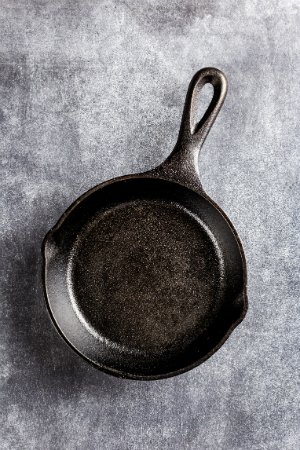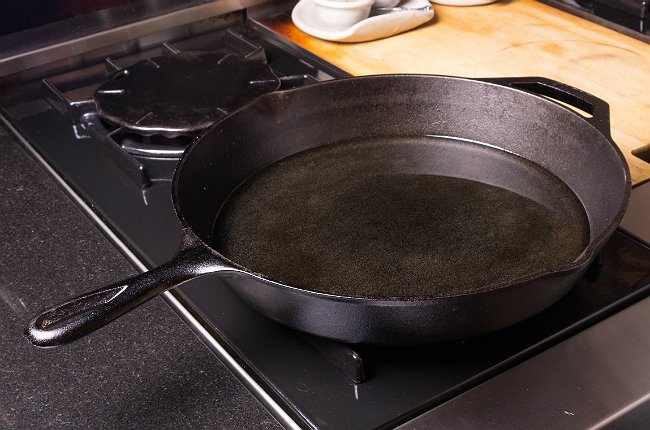We may earn revenue from the products available on this page and participate in affiliate programs. Learn More ›
Use well-seasoned cast-iron cookware once, and chances are that you’re hooked for life. More than simply a nontoxic, nonstick, durable, and long lasting material, cast iron also boasts even larger advantages that at-home chefs adore, such as even heating and flavor enhancement. While that long list of benefits may make switching to cast iron seem like the obvious choice, a few downsides slow homeowners from doing so—namely the confusion surrounding its care and cleaning. But don’t let that scare you off from investing in kitchen mainstays that can last years—even generations—to come. We’ve simplified its maintenance into a series of crucial dos and don’ts to ensure that you get the longest, most productive use from your cast-iron cookware.

DO season your new cast-iron cookware before you use it.
Even if a new pan is advertised as nonstick or preseasoned, you should give it a good seasoning before its first use. This process involves baking oil into the pan or skillet at a high temperature to seal the cast iron, ultimately protecting the pan from moisture and rendering it nonstick. In the words of the Lodge Cast Iron website, “The more you cook, the better it gets.”
To season your cookware, preheat your oven to 325 degrees Fahrenheit. While the oven warms, wash and thoroughly dry the skillet. Then, using a paper towel, apply a thin coating of vegetable oil to the inside and outside of the skillet. But beware: Too much oil will make the pan sticky, so keep your coating light. Place the skillet upside down in the oven on the middle rack, and lay a sheet of aluminum foil over the bottom rack to catch any drips. Bake for one hour, then turn off the oven and allow the skillet to cool completely before removing it.
DON’T send cast-iron cookware through the dishwasher.
Putting your cookware in the dishwasher or using harsh detergents or abrasive scrubs will break down the seasoning, removing the nonstick coating and flavor-enhancing properties of your cast iron.
DO clean your skillet as soon as you’re done cooking.
If you’re a “leave it in the sink to soak overnight” kind of cook, cast-iron cookware isn’t for you. Rinse your pan while it’s still warm (not too hot) as soon as you’re done cooking. If you need to dislodge cooked-on food, certified House Cleaning Technician and author of Clear the Clutter, Find Happiness Donna Smallin Kuper suggests using a credit card instead of a store-bought scraper to gently remove the residue. A handful of sea salt, a touch of vegetable oil, and a plastic scouring pad or poly dish scrubber will scrub off what’s left. Rinse the pan with water and dry immediately.
The Lodge website also suggests that you “rub with a light coat of vegetable oil after every wash,” then set the seasoning by placing the cookware over a burner set on low heat for three to four minutes.
DON’T let it stay wet.
Cast iron is still, after all, iron, and iron rusts when exposed to water for too long. For that reason, leave wet tasks like boiling water to your other cookware, and let your cast iron tackle the searing, baking, frying, and other non-water-based cooking. When it’s time to wash your wares, dry cast iron immediately after in order to prevent rust and to preserve the nonstick surface.
DO reseason if your pan feels sticky, loses its nonstick properties, or looks gray.
Cast iron needs to be reseasoned on occasion, and the signs that the time has come are easy to spot. To reseason your pan, scrub it thoroughly with a touch of dish soap and a plastic scrub brush, dry it completely, then season it just as you would before a first use. Because it can remove the seasoned nonstick coating, soap is not recommended as a regular cleaner, but it can be used to prepare cast iron just prior to reasoning.
DON’T throw out your pan if it develops rust.
Clean off all rust with a metal scouring pad or fine steel wool, then wash the pan thoroughly using water, a soft brush, and a small amount of soap—if you feel you must use soap at all. Rinse and dry the pan immediately, then reseason the pan as if you’re seasoning it before a first use.
With proper care, cast-iron cookware can last 100 years or more. If you haven’t fallen in love with your cast-iron cookware yet, forget about the seasoning and cleaning challenges and just start cooking. It’s really hard to mess up a cast-iron skillet for good. Scrubbing and reseasoning can almost always give cast-iron cookware a new life and provide a second chance for cooks who are just getting to know their cookware. Great cooking opportunities and unlimited second chances? Just two more good reasons to give your old cast-iron cookware a try.

